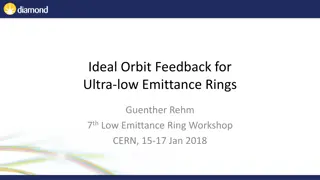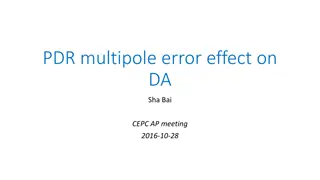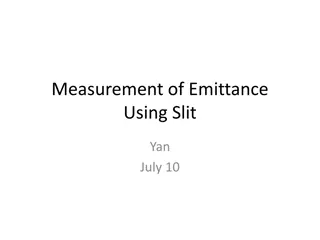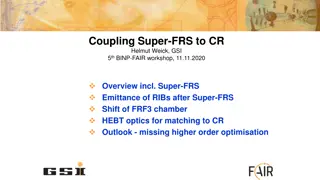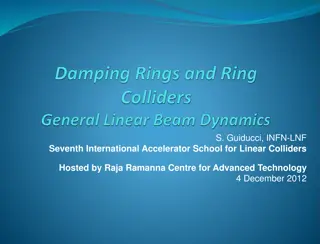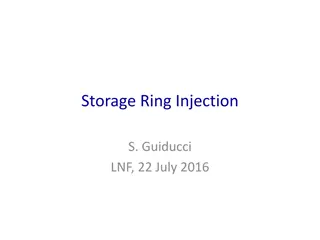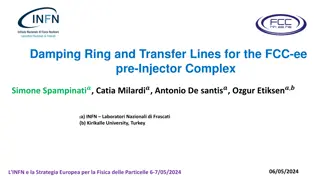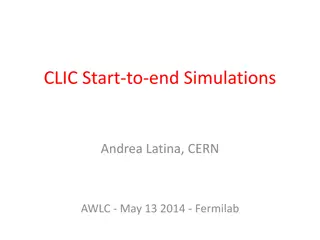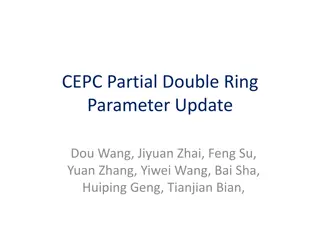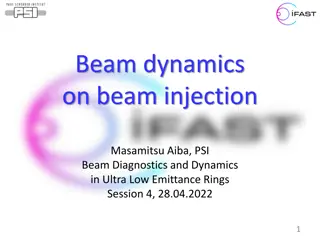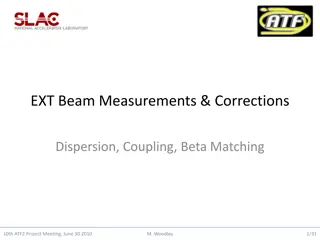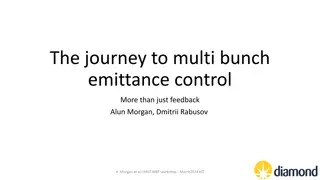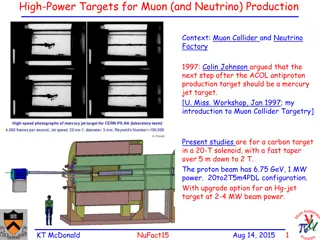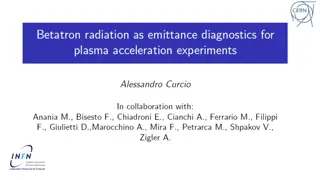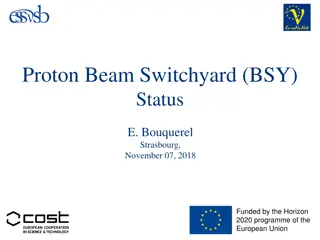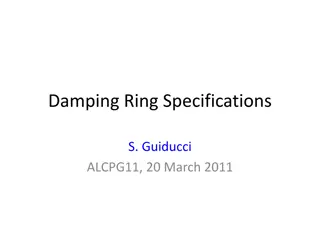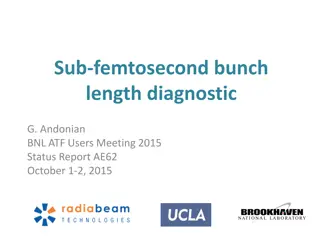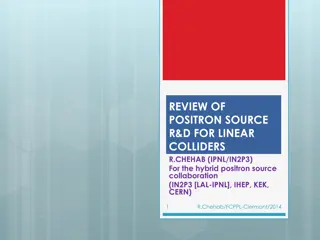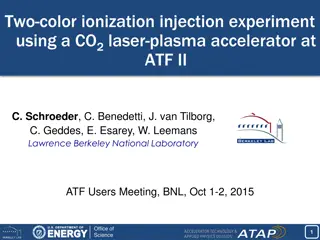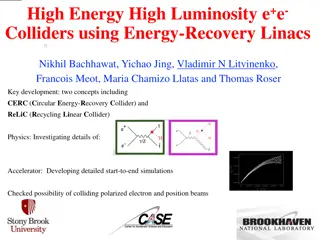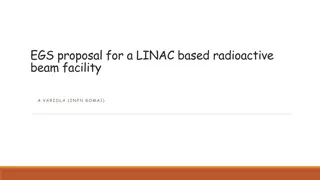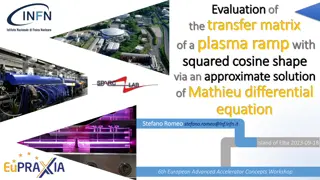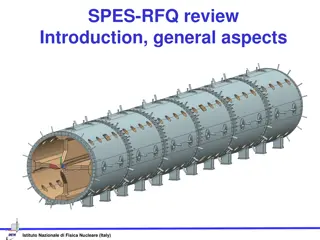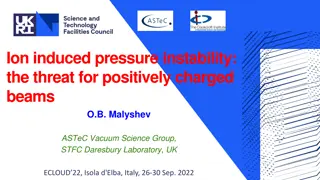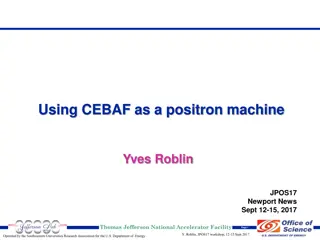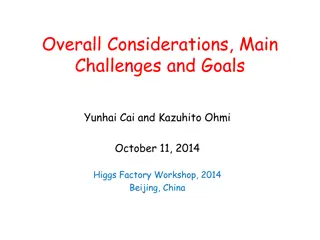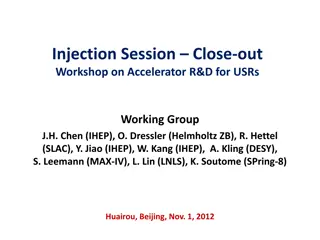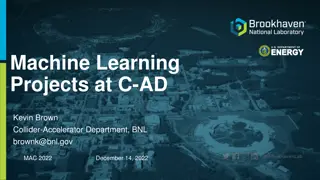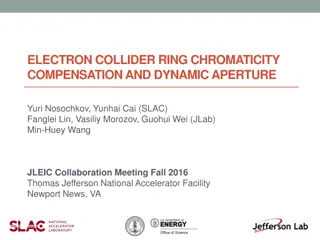Ideal Orbit Feedback for Ultra-low Emittance Rings Workshop Summary
The workshop on Ideal Orbit Feedback for Ultra-low Emittance Rings by Guenther Rehm at CERN in January 2018 covered topics such as Orbit Feedback Motivation, Bandwidth, Latency, Control Techniques, and References for further reading. The presentation highlighted the importance of precise beam positi
1 views • 27 slides
Analysis of Multipole Error Effects on Beam Dynamics in CEPC Accelerator
The content discusses the impact of multipole errors on the beam dynamics at the CEPC Accelerator, focusing on sources of error, measurements, and potential effects on the beam. The analysis includes different types of multipole errors, their sources, and the resulting changes in tune and emittance
4 views • 11 slides
Emittance Measurement Using Slit: Yan July 10
Explore the process of measuring emittance using a slit as illustrated in the images. Witness the detection screen and beam setup, along with the use of multiple slits and viewers for analysis and observation.
1 views • 4 slides
Overview of Super-FRS Coupling to CR and Beam Envelopes
Overview of the Super-FRS coupling to CR including details on beam envelopes, acceptance after target Super-FRS, emittance of RIBs, and outlook for optimization. The content covers floor coordinates verification, beam envelopes at various points, ion reactions like fission and fragmentation on C-tar
2 views • 10 slides
Emittance Measurement Techniques and Analysis
Various emittance measurement techniques like Solenoid and Viewscreen, Single Slit and Viewscreen are discussed in this document along with details on the measurement process, equipment setup, and data analysis methods. Emittance calculations, beamlet intensity profiles, and space-charge dominated b
0 views • 11 slides
Cryogenic Gas Stopping Cell for High Precision Nuclear Physics Experiments
In the field of nuclear physics, high-quality ion beam parameters are essential for both primary and secondary beams. This report focuses on the cryogenic gas stopping cell, also known as a gas catcher, designed to transform rare ion beams from nuclear reactions into low-energy beams with small emit
2 views • 12 slides
Overview of Damping Rings in Linear Colliders
This content provides insights into the basics of damping rings in linear colliders, covering topics such as ring equations of motion, betatron motion, emittance, transverse coupling, dispersion, and momentum compaction factor. It delves into the equations of motion governing particle behavior in el
4 views • 34 slides
Injection Process in Particle Accelerators
The injection process in particle accelerators involves transferring beams efficiently with minimal loss and emittance dilution. It includes on-axis injection onto the reference orbit using septum magnets and fast kickers to maintain beam trajectory accuracy. The design aims to achieve precise beam
0 views • 22 slides
Overview of Damping Ring and Transfer Lines for FCC-ee Pre-Injector Complex
The Damping Ring and Transfer Lines play a crucial role in the FCC-ee Pre-Injector Complex, aiming to damp the emittance of both beams and operate the damping ring at higher energy levels. Coordinated by experts like C. Milardi and A. De Santis, the project includes designs for the Damping Ring, Tra
0 views • 29 slides
CLIC Start-to-End Simulations Overview
Review of CLIC start-to-end simulations including main simulation codes, past results, and upcoming work. Focus on realistic performance assessments, tolerance evaluations, emittance transport, mitigation techniques, operational scenarios, luminosity studies, and tools used. Detailed information pro
0 views • 12 slides
Cutting-Edge Technology in Low Emittance Rings Development
Cutting-edge technology in low emittance rings is being advanced through the EuCARD-2 project, co-funded by partners and the European Commission. Key topics include magnets, wiggler development, RF systems, and impedance aspects. Recent discussions at ALERT2014 highlighted advancements in NEG coatin
0 views • 24 slides
CEPC Partial Double Ring Parameter Update
The CEPC Partial Double Ring Layout features advantages like accommodating more bunches at Z/W energy, reducing AC power with crab waist collision, and unique machine constraints based on given parameters. The provided parameter choices and updates aim to optimize beam-beam effects, emittance growth
0 views • 14 slides
Insights into Beam Injection Dynamics for Ultra Low Emittance Rings
Delve into the critical aspects of beam injection dynamics for ultra low emittance rings, focusing on top-up injection principles, various injection schemes, and key parameters essential for maximizing beam performance and stability in high-energy physics applications.
0 views • 21 slides
Overview of Electron/Positron Injector Linac Upgrades at KEK
The recent status of the Electron/Positron Injector Linac at KEK, presented by Kazuro Furukawa, highlights the mission to achieve 40 times higher luminosity in the SuperKEKB collider. The upgrades include low emittance, low energy spread injection beams with higher beam current, new high-current pho
0 views • 23 slides
Beam Measurements and Corrections at 10th ATF2 Project Meeting (June 30, 2010)
Detailed discussions on beam measurements, corrections, dispersion, coupling, and beta matching were presented at the 10th ATF2 Project Meeting. Various parameters, emittance, coupling measurement, and correction methods were examined, highlighting the importance of precise alignment and adjustments
0 views • 31 slides
Enhancing Emittance Control Strategies in Particle Accelerators
The journey to multi-bunch emittance control goes beyond mere feedback mechanisms, involving nuances like pinhole cameras as detectors and skew quadrupole magnets as actuators. This innovative approach aims to overcome limitations of existing systems like coupling control issues and hysteresis perfo
0 views • 16 slides
High-Power Targets for Muon and Neutrino Production
Colin Johnson advocated for a mercury jet target as the next step for muon production post-ACOL. Current studies focus on a carbon target with proton beam parameters optimized for muon generation. Carlo Rubbia discussed a potential Muon-Collider Higgs Factory concept at CERN, sparking debate on muon
1 views • 11 slides
Plasma Acceleration and Betatron Oscillations Beam Characterization Method
The method for evaluating the quality of beams accelerated through plasma acceleration and betatron oscillations involves non-intercepting diagnostics to infer information about the electrons while inside the accelerating structure. It includes measuring the rms emittance and correcting the betatron
1 views • 12 slides
Proton Beam Switchyard (BSY) Status Summary - Horizon 2020 Programme
A detailed overview of the Proton Beam Switchyard (BSY) Status funded by the Horizon 2020 programme of the European Union. The aim of BSY is to ensure efficient distribution and focusing of the proton beam onto specific targets. The BSY composition includes various systems like deflecting, focusing,
0 views • 12 slides
ILC Damping Ring Specifications and Recommendations
Specifications and recommendations for the ILC Damping Rings include nominal parameters for injected and extracted beams, positron acceptance criteria, longitudinal acceptance guidelines, energy acceptance with quantum lifetime considerations, and layout components for injection/extraction systems.
1 views • 13 slides
Sub-femtosecond Bunch Length Diagnostic and Machine Performance Optimization
Characterizing bunch profiles of sub-ps pulses for machine performance optimization and understanding beam variations in emittance. Current bunch length measurement techniques are limited to a few fs, prompting the need for femtosecond resolution. Techniques like Coherent Radiation Interferometry an
0 views • 15 slides
Review of Positron Source R&D for Linear Colliders by R. Chehab
Intense positron sources, whether polarized or not, are vital for future e+e- linear colliders. This review covers different types of e+ sources, including circularly polarized photons and methods to obtain polarized positrons. Techniques such as helical magnetic undulators and Compton backscatterin
1 views • 26 slides
Two-Color Ionization Injection Experiment Using CO2 Laser-Plasma Accelerator
This experiment conducted at ATF II focused on generating beams with ultra-low transverse emittance utilizing two-color ionization injection with a CO2 laser-plasma accelerator. The technique involves using a pump laser pulse in circular polarization and an injection laser pulse in linear polarizati
0 views • 15 slides
Colliders using Energy-Recovery Linacs
Developments in high-energy e+e- colliders using Energy-Recovery Linacs have led to key concepts like CERC and ReLiC, aiming to enhance luminosity and energy reach. These advancements involve detailed accelerator simulations, flat low emittance beams, energy recycling and reuse, and the possibility
0 views • 11 slides
LINAC-Based Radioactive Beam Facility Proposal
Proposal for a LINAC-based radioactive beam facility at VARIOLA (INFN ROMA1), aiming to serve the needs of the Romanian research community with added value in the present research framework. The project constraints focus on utilizing existing elements, minimizing hardware modifications, and ensuring
0 views • 16 slides
CEPC Local Double Ring Scheme Parameter Study and IR Design
This study focuses on the parameter study and IR design for the CEPC local double ring scheme. It discusses machine constraints, given parameters, energy acceptance, emittance growth, beam lifetime limitations, effective bunch length, and more. The research aims to optimize the CEPC scheme for enhan
0 views • 16 slides
Evaluation of Transfer Matrix of Plasma Ramp with Squared Cosine Shape
Analyzing the transfer matrix of a plasma ramp with a squared cosine shape using an approximate solution of Mathieu differential equation. The evaluation includes optimization of emittance preservation, theoretical plasma focusing strength, and analytical and numerical solutions. Various methods lik
0 views • 15 slides
Virtual Accelerator for Beam Injection Efficiency
Construction budget constraints in Phase II commissioning require careful planning for Linac energy margins and backup preparations. With multiple linac sections and potential failure modes to consider, achieving low emittance beam injection is crucial for operational success.
0 views • 8 slides
SPES-RFQ Design for CW Applications at Linac 10-Tsukuba
This review introduces and discusses the general aspects of the SPES-RFQ design by Andrea Pisent for continuous wave (CW) applications at Linac 10-Tsukuba, undertaken at the Istituto Nazionale di Fisica Nucleare in Italy. It covers key design choices, critical requirements, organizational structure,
0 views • 9 slides
Understanding Ion-Induced Pressure Instability in Positively Charged Beams
Ion-induced pressure instability poses a threat to positively charged beams due to the formation of an ion cloud along their path. This instability leads to beam emittance blow-up and can be mitigated by improving pumping systems and utilizing ion collectors. The phenomenon involves the generation o
0 views • 33 slides
Advanced Positron Machine Development at CEBAF
Explore the innovative development of a positron machine at CEBAF, as discussed in the JPOS17 workshop by Yves Roblin. The machine layout details various options and limiting parameters of the lattice, electron injection, linac optics, and positron generation systems. Emittance, energy spread, bunch
0 views • 21 slides
Challenges and Goals in Lattice Design for Higgs Factory Workshop
Discussing the main challenges and goals in lattice design for a Higgs Factory workshop, focusing on achieving a significant increase in luminosity at beam energy 120 GeV with low emittance lattice and high packing factor of magnets while considering affordability. The content covers design paramete
0 views • 14 slides
Injection Session Close-out Workshop on Accelerator R&D
Explore the latest developments in injection techniques for accelerators, including top-up injection, pulsed multipole injection schemes, and swap-out injection. Key topics include sensitivity to residual orbit transients, low beam emittance requirements, and injector reliability. Stay informed abou
0 views • 7 slides
Optimizing Beam Orbit Correction with MICADO Routine
Learn about the MICADO routine for global orbit correction in the CLIC main linac, reducing setting errors and noise sources by selecting a subset of correctors. Gain insights on the response matrix, correction process, and emittance growth reduction in the linac. Explore MICADO simulations and lite
0 views • 28 slides
Innovative Machine Learning Projects in Collider-Accelerator Department
Explore groundbreaking machine learning projects at C-AD led by Kevin Brown in collaboration with various institutions, focusing on areas like Bayesian optimization, emittance measurement, natural language processing, and collaboration with other research facilities.
0 views • 27 slides
Electron Collider Ring Chromaticity Compensation Study
Explore the study on chromaticity compensation in electron collider rings presented at the JLEIC Collaboration Meeting. Strategies for correcting non-linear chromatic perturbations, enhancing dynamic aperture, and minimizing impact on beam emittance are discussed in detail. Various correction scheme
0 views • 17 slides
